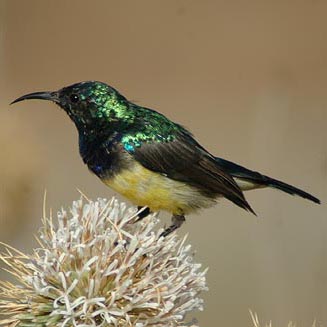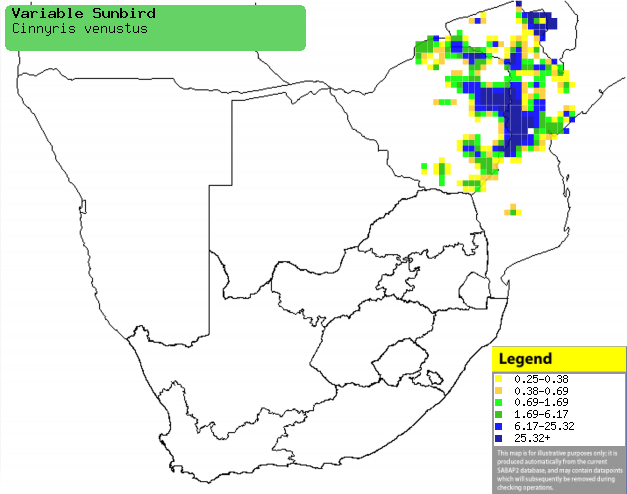|
Cinnyris venustus (Variable
sunbird, Yellow-bellied sunbird)
[= Nectarinia venusta]
Geelpenssuikerbekkie [Afrikaans]; Dzonya, Tsodzo (both are
generic names for sunbird) [Shona]; Ornaathoningzuiger [Dutch]; Souimanga à
ventre jaune [French]; Gelbbauch-nektarvogel [German];
Beija-flor-de-barriga-amarela [Portuguese]
Life
> Eukaryotes >
Opisthokonta
> Metazoa (animals) >
Bilateria >
Deuterostomia > Chordata >
Craniata > Vertebrata (vertebrates) > Gnathostomata (jawed
vertebrates) > Teleostomi (teleost fish) > Osteichthyes (bony fish) > Class:
Sarcopterygii (lobe-finned
fish) > Stegocephalia (terrestrial
vertebrates) > Tetrapoda
(four-legged vertebrates) > Reptiliomorpha > Amniota >
Reptilia (reptiles) >
Romeriida > Diapsida > Archosauromorpha > Archosauria >
Dinosauria
(dinosaurs) > Saurischia > Theropoda (bipedal predatory dinosaurs) >
Coelurosauria > Maniraptora > Aves
(birds) > Order: Passeriformes
> Family: Nectariniidae
 |
|
|
Variable sunbird male, Mai Hutsa, near Asmara, Eritrea.
[photo
Solomon Abraha ©] |
|
Distribution and habitat
It has two separate populations in sub-Saharan Africa, one
in West Africa and the other extending from Eritrea, through Uganda, Ethiopia
and Tanzania to southern Africa. Here it is uncommon to locally common in
central Mozambique and the eastern half of Zimbabwe, generally preferring moist
habitats with dense undergrowth, such as Burkea savanna, miombo (Brachystegia)
woodland, herbaceous scrub on highlands and along rivers, edges of evergeen
forest, sheltered valleys cut into hillsides and Protea-strewn hills.
|
 |
|
Distribution of Variable sunbird in southern Africa,
based on statistical smoothing of the records from first SA Bird Atlas
Project (©
Animal Demography unit, University of
Cape Town; smoothing by Birgit Erni and Francesca Little). Colours range
from dark blue (most common) through to yellow (least common). |
Predators and parasites
It has been recorded as host of the following parasites:
- Blood parasites
- Leucocytozoon nectarinae
- Haemoproteus sequirae
- Plasmodium
- Feather mites
- Pterodectes hologaster
- Xolalges glossopus
Food
It eats nectar supplemented with arthropods, gleaning prey
from plant stems and leaves and hawking insects aerially. The following food items have been recorded
in its diet:
- Nectar
- Erythrina latissima (Broad-leafed coral-tree)
- Combretum paniculatum (Forest burning-bush combretum)
- Faurea rochetiana (Broad-leaved beachwood)
- Loranthaceae (mistletoes)
- Leonotis (wild dagga)
- Salvia
- Kniphofia (torch lilies)
- Protea
- Jacaranda mimosifolia (Jacaranda)
- Arthropods
Breeding
- The nest is built mainly by the female in about 10-20 days, consisting of
an oval-shaped structure made of fine grass stems and blades, sometimes
along with dry reeds, fibres, rootlets, withered leaves and flower heads
bound together with spider web. A circular entrance hole is position on the
side-top of the nest, sometimes with a "porch" of stiff grass stems
protruding beneath it. It is often camouflaged with large bits of material,
while the interior is thinly lined with silvery thistle down, Clematis
seeds and other woolly plant material. It is typically placed in a tall
weed or small sapling in recently burnt woodland with sparse undergrowth,
although it may occasionally use a deserted building instead.
- Egg-laying season is year round, peaking from March-June and in
September.
- It lays 1-2 eggs, which are incubated solely by the female for about 14
days, leaving the nest intermittently in the morning and late afternoon to
go and forage.
- The chicks are brooded solely by the female but fed by both parents,
leaving the nest after about 12-16 days.
Threats
Not threatened.
References
-
Hockey PAR, Dean WRJ and Ryan PG 2005. Roberts
- Birds of southern Africa, VIIth ed. The Trustees of the John Voelcker
Bird Book Fund, Cape Town.
|
